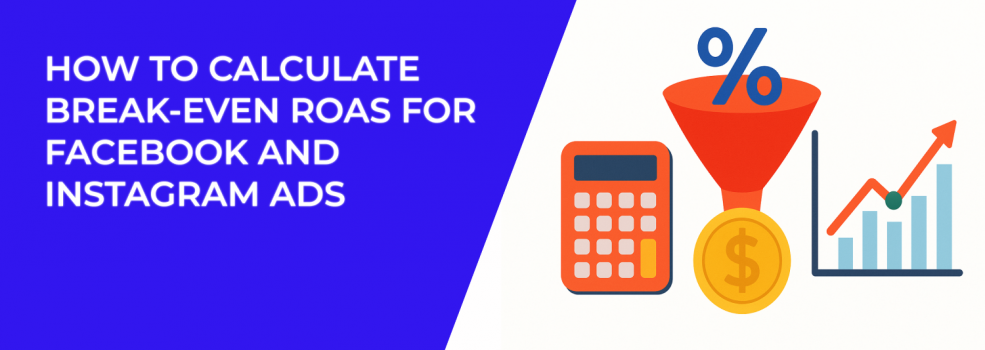Running Facebook or Instagram ads without knowing your break-even ROAS is like steering a car with your eyes half-closed. You might stay on the road for a while — but eventually, you'll veer off course and waste money without even realizing it.
To avoid that, you need clarity. And break-even ROAS gives you exactly that. It’s not just another performance metric — it’s your baseline for profitability.
Let’s break down what break-even ROAS actually means, how to calculate it step by step, and how to use it to make sharper advertising decisions on Facebook and Instagram.
What Is Break-Even ROAS and Why Should You Care?
ROAS stands for Return on Ad Spend. Your break-even ROAS is the minimum ROAS your campaign needs to not lose money. In other words, it's the point where your revenue from ads exactly matches your total business costs — including product, shipping, fulfillment, platform fees, and, of course, the ad spend itself.
Here’s why this metric is critical: it helps you evaluate whether your Facebook or Instagram ads are financially viable. If you're below that threshold, you're operating at a loss. If you're above it, you're profitable.
Marketers often chase high ROAS numbers — 3.0, 4.0, or even 5.0 — without knowing whether those numbers are good for their business model. A 2.5 ROAS could be a win for one business and a loss for another. Your break-even ROAS helps you define that line clearly.
The Simple Formula for Break-Even ROAS
Let’s keep the math friendly. The formula is straightforward:
Break-Even ROAS = 1 / Profit Margin
Your profit margin is calculated as:
Profit Margin = (Revenue – Cost of Goods Sold) ÷ Revenue
Say you're selling a product for $100. If it costs you $60 to produce, package, and ship it, your profit is $40. That makes your profit margin 40%.
Now apply the formula:
Break-Even ROAS = 1 ÷ 0.4 = 2
This means that for every $1 you spend on Facebook or Instagram ads, you need to make $2.50 in return to cover your costs. Any lower, and you’re losing money.
It’s a basic calculation — but don’t let the simplicity fool you. This one number has the power to make or break your ad strategy.
Real-World Example: Calculating Break-Even ROAS
Let’s walk through a real-world example that applies to most e-commerce businesses.
Imagine you’re selling a fitness tracker online:
-
Selling price: $80;
-
Total cost per unit (product + packaging + shipping + transaction fees): $50;
-
Profit per sale: $30;
-
Profit margin: $30 ÷ $80 = 0.375.
Now calculate the break-even ROAS:
Break-Even ROAS = 1 ÷ 0.375 = 2.67
So if you’re spending $100 on ads, your campaign needs to generate at least $267 in revenue to break even. Anything below that — even a ROAS of 2.4 — and you're eating into your margins.
Now imagine running 10 campaigns without knowing this. You might think you're performing well because the ROAS looks decent, but you could be quietly losing hundreds or even thousands of dollars.
What Factors Can Change Your Break-Even ROAS?
Your break-even ROAS isn’t carved in stone. It can shift over time based on several variables in your business. Understanding these helps you stay ahead of changes that may silently eat into your margins.
Here are some of the key factors that can increase or decrease your break-even ROAS:
-
Cost of Goods Sold (COGS):
If your suppliers raise prices, or you start paying more for packaging or raw materials, your costs go up — and your margins go down. That means your break-even ROAS will rise. -
Discounts and Promotions:
Offering a 20% discount on a $100 product instantly reduces your revenue per sale to $80. Unless your costs also decrease, your profit margin shrinks, and your break-even ROAS increases. -
Average Order Value (AOV):
When you succeed in increasing the average customer purchase — say, through upsells or product bundles — your profit per transaction goes up. That gives you more wiggle room and lowers your break-even ROAS. -
Platform and Payment Fees:
Fees from platforms like Shopify, Stripe, or PayPal can add up. Many businesses forget to include these in their cost calculations, which leads to misleading ROAS expectations. -
Fulfillment and Shipping:
Whether you’re using a 3PL or handling fulfillment in-house, these costs matter. They often fluctuate with order volume and geography, and can quietly erode your margins if not tracked.
Each of these variables may seem small on its own — but together, they can push your break-even ROAS higher than expected. That's why it's important to revisit your numbers regularly.
How to Use Break-Even ROAS in Your Ad Strategy
Knowing your break-even ROAS is only half the equation. What you do with it is what really drives impact.
Once you’ve calculated your number, here’s how to apply it in your campaign analysis and planning:
-
Use it as your performance threshold:
When reviewing campaigns inside Meta Ads Manager, compare your actual ROAS to your break-even figure. If you're underperforming, adjust creative, targeting, or placements before scaling spend. -
Segment by audience or funnel stage:
Break-even ROAS can vary by audience type. Cold traffic may need to hit a lower ROAS upfront if you're factoring in long-term value; retargeting should deliver higher immediate returns. -
Adjust your bidding and budgeting strategy:
Use your break-even ROAS as a guide for setting bid caps or cost controls. Campaigns that frequently fall below it shouldn’t be scaled unless they’re part of a longer funnel or nurture sequence. -
Incorporate customer lifetime value (CLTV):
If you know that a customer who buys once is likely to return, you can afford to run ads that break even — or even lose money — on the first purchase. But this only works if you actually track and understand your lifetime value.
To structure campaigns that support sustainable performance, make sure your Meta campaign objectives match your ROAS goals from the start.
What If You’re Not Hitting Break-Even ROAS Yet?
It happens. Especially in the early stages of a campaign or when testing new creatives or audiences.
Here’s how to approach the situation if your ROAS is falling short:
-
Re-evaluate your product pricing:
Are you charging enough to maintain healthy margins? A small price increase can have a big impact. -
Look for margin killers:
Audit your fulfillment, packaging, and processing fees. Even a few dollars per sale can dramatically affect your break-even point. -
Improve your AOV:
Add upsells, bundles, or volume discounts to encourage larger checkouts. -
Refine your targeting:
Weak audience targeting often leads to low-quality clicks that don’t convert. Consider revisiting the basics in this guide to Facebook Ad Targeting 101 for a better approach. -
Boost conversion rates:
Sometimes the problem isn’t the ad — it’s the landing page. If users are clicking but not converting, optimize your offer, page speed, or user experience. -
Fix underperforming campaigns:
If your ROAS looks weak across the board, this guide to Facebook Ads Not Converting provides a solid list of things to check and optimize.
Also, if your ads are stuck in the learning phase, performance will be inconsistent. Don’t overlook this — see How to Finish the Facebook Learning Phase Quickly for fast ways to stabilize results.
And if your campaign isn’t delivering at all, review Why You See “Ad Set May Get Zero” to rule out delivery issues that can quietly kill profitability.
Final Thoughts
Calculating your break-even ROAS is one of the most valuable steps you can take to stop wasting money on Facebook and Instagram ads. It’s a straightforward metric, but it provides deep insight into your ad performance — and your business health overall.
When you know your break-even point, you can stop relying on guesswork. You can confidently adjust bids, pause underperforming ad sets, and scale winners with purpose. In short, it allows you to advertise with control.
Whether you're running ads for a Shopify store, managing client accounts, or testing your first Meta campaign, understanding your break-even ROAS isn't optional — it's essential.

